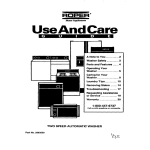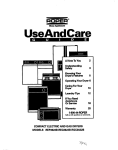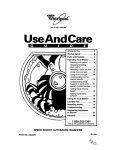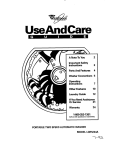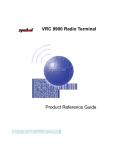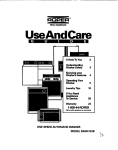Download Whirlpool RABZl32D Specifications
Transcript
UseAndCare+ l-F71 r A Note to You ... ...... ... .... 2 Washer Safety .... ....... .... 3 Parts and Features . ...... 4 Operating Your Washer ............ V...... ....... . 5 Caring for Your Washer .. .. ... ......... ...... ..... 9 Laundry Tips . ... .. ....... .. 10 Removing Stains . ....... 14 Troubleshooting .... .. ... 17 Requesting Assistance or Service .. .... ..... ...... ... 19 Warranty .......__.............20 l-800-447-6737 Call us with question8 or comments. ONE SPEED AUTOMATIC WASHER Part No. 3363649 MODELS RABZl32D RAB3132D A Note to You Thank you for buying a Ropefl appliance. Roper appliances give you all the functionality of name brand appliances at a value price. To ensure you enjoy years of trouble-frw operation, we developed this Use and Care Guide. It contains valuable information about how to operate and maintain your appliance properly and safely. Please read it carefulfy. Also, please complete and mail the Ownership Registration Card provided with your appliance. This card helps us notify you about any new information on your appliince. Please record your model’s information. Whenever you call to request service on your appliance, you need to know your complete model number and serial number. You can find this information on the model and serial number plate (see diagram on page 4 for location of plate). Please also record the purchase date of your appliance and your dealer’s name, address, and telephone number. Keep this book and the sales slip together I 2 Call our toll-free 24 hours a day. number Model Number Serial Number Purchase Date Dealer Name Dealer Address Dealer Phone in a safe place for future reference. 1-800-447-6737 1 Washer Safety Your safety is important to us. This guide contains safety statements under warning symbols. Please pay special attention to these symbols and follow any instructions given. Here is a brief explanatbn of the symbol. IMPORTANT SAFH-Y INSTRUCTIONS reduce the risk of fire, electrical shock, or injury when using your washer, follow basic precautions including the following: Read all instructions before using your washer. l Do not machine wash or machine dry items cleaned, washed, soaked in, or spotted with wax, paint, gasoline, oil, or other flammable fluids. The fumes can create a fire hazard or explosion. Always hand wash and line dry items containing these materials. l Flammable fluids (drycleaning solvents, kerosene, gasoline, etc.) should not be used or stored in or near your washer. Do not add flammable fluids to your wash water. These substances give off vapors that can create a fire hazard or explosion. l Do not allow children to operate, play with, or crawl on or inside your washer. Supervise children closely when your washer is used near them. l Before your washer is removed from service or discarded, remove the lid to prevent accidental entrapment. @Afterstarting a cycle, do not reach into the basket unless the Cycle Control Knob is pushed in and all motion stops. @Donot tamper with the controls. l If your hot water has not been used recently (usually 2 weeks or longer), hydrogen gases may build up in your water heater and your hot water pipes. HYDROGEN GAS IS EXPLOSIVE. To prevent injury or damage, before using your washer, turn on all hot water faucets and allow water to run for several minutes. This will allow gases to escape. Do not smoke or use any open flame near your faucet while it is open. Please ... l Have only a qualified person install, repair, or replace parts on washer. l Maintain washer properly. l Protect washer from the weather and keep it where the temperature will not fall below freezing. l Install and level washer on a floor that can support the weight.* l Connect washer to the correct 3-prong outlet, electriial supply, water supply, and drain.* l Ground washer properly.* ‘See the Installation Instructions. l - SAVE THESE INSTRUCTIONS 1Jnderstanding l l l your - responsibilities Store laundry aids and other materials in a cool, dry place where children cannot reach them (in a locked cabinet if possible). Read and follow instructions on packages of detergent and laundry aids, especially warnings and precautions. Do not wash or dry items that are soiled with vegetable or cooking oil. These items may contain some oil after laundering. Due to the remaining oil, the fabric may smoke or catch fire by itself. l l l Do not use chlorine bleach and ammonia or acids (such as vinegar or rust remover) in the same wash. Hazardous fumes can form. Unplug power supply cord before attempting to service your washer. Do not machine wash fiberglass materials. Small particles can stick to fabrics washed in following toads and cause skin irritation. 3 Parts and Features The parts and features of your washer are illustrated on this page. Become familiar with all parts and features before using your washer. Page references are included nex-t to some features. Refer to those pages for more information about the features. Load l lze ;;YOr\ Cycle control knob (P-6) Toll-f me Liquid chlorine bleach diepen-r’ (P- ‘3) Agitator -- Model and serial -number l 4 Available on some models plate (under lid) - Basket - Tub Operating Your Washer To obtain the best washing results, you must operate your washer properly. This section gives you this important information. Page references are included for more information. Starting Your Washer 1. Add measured detergent to the washer. Then place a sorted load of clothes In the washer. l Sort and load clothes as described on page 10. l If desired, you may also add color-safe all-fabric bleach. 2. (OPTIONAL STEP) If desired, add measured liquid chlorine bleach. l In model RAB31320, use only liquid chlorine bleach in the bleach dispenser. l Model RAB2132D does not have a liquid bleach dispenser. Add bleach as described on page 8. 3. Close the washer Ild. 4. Select a load size. Turn the Load Size Selector to the setting that corresponds with the size of the wash load and the type of fabric being washed. l To change the toad size setting after the washer has started to fill, move the Selector to the desired new setting. l See pages 10 and 11 for loading tips. 5. Push in and turn the Cycle Conrror Knob clockwise to the wash cycle you want (see page,6). Match wash water temperature with the type of fabric and soils being washed. 6. Pull out C-jcle Control Knob to start washer. 7. (OPTIONAL STEP) If desired, add measured and diluted fabric softener (- paw 8). Stopping/Restarting Washer l l Your To stop the washer at any time, push in the Cycle Control Knob. To restart the washer, close the lid (if necessary) and pull out the Cycle Control Knob. Cycle Model descriptions RABZl32D NOTE: Cvcle times not snown on this model. Model Heavy cycle (both models) Short only) The Heavy cycle features hot wash water for heavy soils and longer spins to shorten drying time. l Use HOT (14 minutes of wash time) to clean large loads of sturdily constructed fabrics that are heavily soiled. Normal cycle (both models) The Normal cycle features warm wash water and longer spins to shorten drying time. l Use WARM (12 minutes of wash time) to clean cotton and linen fabrics that are moderately to heavily soiled. NOTE: For cold wash water, turn Cycle Control Knob to COLD (10 minutes of wash time), or use Short cycle (model FiAB3132D only). 6 RAE3 Y32D cycle (on model RAB3132D The Short cycle features a brief wash cycle with cokl wash water for gentle soil removal. l Use SHORT (6 minutes of wash time) to clean delicate items and washable knits that are lightly soiled. l During the Short cycle, the machine will pause for a brief soak period (2 minutes). Cycle options (both models) You may select different wash times by first selecting the water temperature and then turning to the new wash time. For example, for 12 minutes of wash time with cold water: l Push in Cycle Control Knob and turn it clockwise to COLD. l Pull out Cycle Control Knob and allow your washer to fill. l When your washer has filled, push in and turn Cycle Control Knob ciocKwise to NCRMAL (12 minutes of wash time). l Pull out Cycle Control Knob. Using rinse and spin When using extre detergent for heavily soiled clothes, or washing special-care items, you may want an extra rinse and spin. 1. Push in Cycle Control Knob and turn clockwii until indicator points to RINSE, as illustrated. 2. Pull out Cycle Control Knob. The washer fills to selected toad size, agitates, drains, and spins. Using drain and spin A drain and spin may help shorten drying times for some heavy fabrics or special-care items by removing excess water. 1. Push in Cycle Controt Knob and turn clockwise until indicator points to SPIN, as illustrated. 2. Pull out Cycle Control Knob. The washer drains and then spins. What happens in each cycle When the Cycle Control Knob is set to a number and pulled out, the washer fills (to the selected load size) before agitation and timing start. The washer begins agitating immediately after filling; agitation can occur with the washer lid up or down. After agitation starts, the Cycle Control Knob turns cktckwiie until it points to an OFF area and the cycle ends. RINSE WASH Fill Wash selected time =w w Drain- No agitation Spin Rinse -wt4 Drain-No agitation Spin Adding liquid chlorine Always measure liquid chlorine bleach. Do not guess. Never use more than 1 cup (250 mL) for a full bad. Use less with lower water level settings. Follow manufacturer’s directions for safe use. Use a cup with a pouring spout to avoid spilling. bleach Model RAB3 132D (with dispenser) , Model RAB2132D (no dispenser) 1. Let the washer fill and begin agitating the bad. 2. Add bleach to wash cycle so it can be removed in the rinse cycle. Pour bleach around agitator, not directly on load. l Follow directions on care labels. Do not use chlorine bleach on wool, silk, spandex, acetates or some flame-retardant fabrics. l When soaking with chlorine bleach, add detergent to soak water. NOTE: Undiluted bleach will damage any fabrii it touches. The damage appears as rips, holes, tears, or color loss and may not show up until several washings later. Adding (on both l l l l a fabric softeners models) Always dilute fabric softeners with !4 to 1 cup (125 to 250 mL) warm water. Undiluted fabrii softener can stain fabrics. Add diluted fabrii softener only in the final rinse. Fabric softeners should not be mixed with other laundry products because greasy stains may form. If stains form, remove by wetting the stain and rubbing with liquid detergent or a bar of soap. Rewash the stained item. Too much fabric softener can make some items (diapers and towels) nonabsorbent. If this happens, use less fabric softener or do not use it every time. 1. Load the washer. 2. Pour measured chlorine bleach carefully into the dispenser. Do not let bleach splash, drip, or run down into washer basket. Undiluted bleach will damage any fabric it touches. 3. Start the washer. Bleach will be diluted and dispensed automatically during wash part of cycle. NOTE: Do not use this dispenser to add powdered chlorine or all-fabric bleach to your wash load. The dispenser is for liquid chlorine bleach use only. Caring for Your Washer Proper care of your washer can extend its lie. This section explains how to care for your washer properfy and safely. Cleaning your washer Exterior Interior Wipe up detergent, bleach, and other spills with a soft, damp cloth or sponge as they occur. Occasionally wipe the outside of the washer to keep it looking like new. Do not put sharp or metal objects in your washer. They can damage the finish. Check all pockets for pins, clips, . money, bolts, nuts, etc. . . Do not lay these oqects on your washer after emptying pockets. Winter storage Clean interior with 1 cup (250 mL) of chbrine bleech mixed with 2 cups (500 mL) of detergent. Run washer through a cornplete cycle using hot water. Repeat process if necesaIy. NOTE: Remove hard water deposits using cleaners labeled as washer safe only. or moving care Install and store your washer where it will not freeze. Because some water may stay in the hoses, freezing can damage your washer. lf storing or moving your washer during freezing weather, winterize it. To winterize washer: To use washer again: 1. Shut off both water faucets. 1. Flush water pipes and hoses. 2. Disconnect and drain water inlet hoses. 2. Reconnect water inlet hoses. 3. Put 1 quart (1L) of R.V.-type antifreeze in 3. Turn on both water faucets. the basket. 4. Reconnect power supply cord. 4. Run washer on a drain and spin setting 5. Run the washer through a complete cycle (see page 7) for about 30 seconds to mix with 1 cup (250 mL) of detergent to clean the antifreeze and water. out antifreeze. 5. Unplug the power supply cord. Non-use or vacation You should operate your washer only when you are at home. If you will be on vacation or will not be using your washer for an extended period of time, you should: care l l Unplug the power supply cord or turn off electrical power to the washer. Turn off the water supply to the washer. This helps avoid accidental flooding (due to a water pressure surge) while you are away. Laundry Tips This section reviews proper laundering techniques and gives you additional washing information. Preparing clothes for washing Close zippers, snaps, and hooks to avoid snagging other items. Remove pins, buckles, and other hard objects to avoid scratching the washer intedor. Remove non-washable trim and ornaments. Empty pockets and turn them inside out. Turn down cuffs, brush away lint and dirt. l l l Turn synthetic knits inside out to avoid pilling. l Tie strings and sashes so they will not tangle. . Mend tears, loose hems, and seams. l Treat spots and stains. (See “Removing Stains” on pages 14-l 6.) l Stained or wet garments should be washed promptly for beat results. l Sorting Separate heavily-soiled items from lightlysoiled ones, even if they would normally be washed together. Separate lint givers (towels, chenille) from lint takers (corduroy, synthetics, l l l permanent press). When possible, turn lint givers inside out. Separate dark colors from light colors, colorfast items from noncolorfast items. Sort by fabric and construction (sturdy cottons. knits, delicate items). Loading l l Drop items into washer loosely. Fill to the top of the basket, but do not wrap items around the agitator. Items should move easily through wash water for best Ia cleaning and wrinkle-free results. items should sinkand reappear later. Load washer properly and select correct toad size setting. Overloading or packing the machine, and selecting a setting too small for the wash load can: - cause poor cleaning. - increase wrinkling. - create excessive lint. - wear out items faster (because of pilling). 10 l l l Load by the amount of space items take up, not by their weight. Mix large and small items in each loed. Load eventy to maintain washer balance. An offbalance load ten make the washer vibrate during spin. To reduce wrinkling, permanent press clothes and some synthetic knits should have more room to move in the water than heavy items (towels, jeans). Use the largest load size setting for best results with permanent press clothes. Loading suggestions For these suggested full-sized loads, set the Load Size Selector to the largest load size setting. LARGE CAPACITY WASHERS Heavy Work Permanent Clothes PIBSS 2 pair pants 1 double sheet 3 shirts 1 tablecloth 3 pair jeans 1 dress 1 coverall 1 blouse Knits 2 slacks 2 blouses 4 shirts 4 tops 2 dresses Saving l l l l 2 3 slacks shirts 2 pillowcases 62 pair shirtsshorts 2 blouses 6 handkerchiefs Towels 8 bath towels 8 hand towels 10 wash cloths 1 bathmat Delkates 2 camisoles 4 slips 4 panties 2 bras 2 nighties energy Use warm or cokf wash water for most loads. Use hot water only when washing heavy, greasy soils or whites. Use cold rinses. Wash full loads. Use a smaller load size setting when washing small loads. Manual Mixed Load 2 double or 1 king size sheet(s) 4 pillowcases 6 T-shirts clean l l Avoid rewashing. Use enough detergent and pretreat stains or heavy soils. Use the cycles and wash times recommended for the fabric and soil. Use your washer during off -peak hours usually early morning and late evening. (Ask your power company.) lint filter Clean the filter at the bottom of the agitator after every load for the best filtering results. To clean: 1. Lii off the agitator barrel. 2. Wash or wipe the filter clean in the bottom of the agitator barrel. The filter is not removable. 3. Replace agitator barrel and snap into pk?. Agitator barrel Manual clean lint fitter 11 Water Selecting Guidelines water TEMPERATURE* HOT 130°F (84°C) or above temperatures SUGGESTED FABRICS l l l WARM go”-1 10°F (32”-44”C) l l l l COLD 70”~90°F (21=32”C) l l l l COMMENTS Work clothes Sturdy whites/colorfast pastels Diapers l DaMtoncobrfast colors Permanent press items Nylon, polyester, acrylics, silks, woolens Knitsldelicate fabrics l Extra-sensitive colors Noncobrfast items Hand washables l l l l l l l l Best cleaning for heavily soiled items Removes oils, perspiration, greasy soils, and stains Prevents graying or yellowing Best for lightly soiled to moderately soiled items Safe for most fabric finishes Less fading and dye bleeding Reduces wrinkling Best for very lightly soiled items Saves hot water Best rinse water temperature The washer features cold rinses for all wash temperatures. Checking hot water temperature Your hot water should be 130°F (54°C) or ahove. lf you do not know your hot water temperature, you can check it easily. You may need to raise the temperature of your water heater. To check your hot water: 1. Fill a pan with the hottest water available from the faucet that fills your washer. NOTE: If you do not have a faucet at your washer site, collect the water from the faucet closest to your washer. 2. Place a candy thermometer or cooking thermometer in the water to check the temperature. NOTE: In wash water temperatures colder than 70°F (21 “C), detergents do not dissolve well. Also, soils may be difficult to remove, and some fabrics may retain wear wrinkles and may have increased pilling. 12 Water hardness Many poor washing results can be traced to the hardness of the wash water. To check your water hardness: l City water - ask the city water company. l Well water - ask the local water authority. Ask for the mineral content in grains/gallon or parts/million. If your water is more than 8 grains/gallon or more than 153 parts/ million, you should consider: l Installing a water softener. l Using more detergent. l Using a packaged water conditioner. l Not using soap. Washing special-care items Most garments and household textiles have care labels with laundering instructions. Always follow care label dlrectlons when they are avallable. Below are general washing instructions for some special washables. ITEM CARE INSTRUCTIONS Blankets (electric or woolen) Pretreat spots and stains. Select water temperature, cycle, and time according to the type of blanket being washed. An extra rinse may be necessary (see page 8 for rinse and spin information). Check care label to see if manufacturer recommends machine washing. Curtains, drapes, sllpcovers Wash small loads. Crowding may cause wrinkling. Replace slipcovers while still slightly damp. They will dry to fii tightly. NOTE: Sun-damaged curtains and draperies will tear whether hand or machine washed. Diapers When using chlorine bleach for soaking, add extra detergent to the load. Avoid overuse of fabric softeners - absorbency will be reduced. Elastic, spandex Elastic picks up oil from the body. Oil can damage elastic. Wash often to reduce the damage. Use warm water and sufficient detergent to remove oils. Do not use chlorine bleach. Flame-retardant clothing Items will be clearfy tabeled as flame-retardant. Follow manufacturer’s instructions to retain flame-retardant qualities. Knits Knits are comfortable to wear because they stretch. However, this means that knits are more likely to be stretched and damaged when washed (especially bulky knits). Knits made of synthetic fabrics such as polyester, nylon, and acrylic tend to keep their original shape more than a knit made of cotton or ramie. Pillows, stuffed toys Washing feather pillows is not recommended unless they will be dried in a dryer. Plastic, rubber items Treat as delicate items. Wash in warm water. Wash small items inameshbag. Oulfts, bedspreads Do not wash cotton-filled comforters unless they are quilted or stitched. Tucked cotton batting tends to slip and become lumpy. An extra rinse may be necessary. Scatter rugs Shake or vacuum rugs to remove loose dirt. Wash more than one rug at a time. lf washing only one rug, add bath towels to balance the load. Snowsuits, jackets Wash only one or two items at a time. You may need to stop the washer occasionally to press air from the items being washed. An extra rinse may be necessary. 13 Removing Stains Stained, heavily-soiled, or greasy items may need to be prewashed or soaked for best results. Soaking helps remove protein-type stains like blood, milk, or grass. Prewashing helps loosen soil before washing. Stain l l l l l removal rules Use warm water for soaking or prewashing stained laundry. Hot water can set stains. Most stains are easier to remove when they are fresh. Old or set stains may not come out. Follow package directions for pretreatment products. Before treating any stain, find out what kind of stain it is, how old the stain is, what kindoffabricitis,andifthefabricis colorfast. (Check the care label.) Washing and drying can set some stains. Start with cold or warm water. Hot water can set some stains. Stain removal l l l l When bleach is recommended, use a bleach that is safe for the fabric. Test stain removers on an inside seam or hidden corner of the item to see if the color is removed. Put the stained area face down on a paper towel or white cloth. Apply the stain remover to the back of the stain. This forces the stain off the fabric instead of through it. Meat tenderizer or enzyme presoaks help break down some protein stains so they are easier to remove. guide STAlN TO REh4OM Alcoholic beverage These stains turn brown with age, so treat immediately. Sponge or soak fresh stains with cold water. Wash. If stain remains, soak 15 minutes in a solution of lukewarm water, liquid detergent, and a few drops of white vinegar. Rinse. Wash. Blood Rinse immediately or soak in cold water with enzyme presoak for 30 minutes or longer. Rinse. Rub detergent into any remaining stains. Rinse. If stain remains, put a few drops of 3% hydrogen peroxide on stain for 3-5 minutes. Rinse thoroughly. Wash. Chewlng gum Chocolate or coffee Use ice to make gum hard. Scrape off what you can. Sponge with a nonflammable fabric cleaner. Let dry. Wash. Sponge immediately with a nonflammable fabric cleaner or apply a prewash soil and stain remover. Rinse. Wash. lf stain remains, apply a liquid detergent to stain or soak in warm water with an enzyme presoak. Rewash. Crayon and candle wax Scrape off excess with a dull knife. Place fabric between two blotters or facial tissue. Press with warm iron. Remove color stain with nonflammable fabric cleaner. Hand wash until stain is gone. If full load is crayon stained, take to cleaners or winoperated dry cleaning machine. Cream, milk, or Ice cream Sponge with a nonflammable fabric cleaner, or a prewash soil and stain remover. Rinse. Wash. Repeat if necessary. lf stain remains, apply a few drops of liquid detergent and a few drops of ammonia. Blot dry and rinse. If stain remains, soak in an enzyme presoak. Wash. 14 STAIN TO REMOVE Deodorants and antlpersplrants Llght stain: Treat with liquid detergent or your regular laundry detergent. Wash in hottest water safe for fabric. Heavy staln: Place face down on towel and treat with a paste of ammonia and all-fabric bleach. Let stand for 30 minutes. Wash in hottest water safe for fabric. Fat, grease, or 051 Items soiled with vegetable or cooking oil shoukf not be washed or dried. See vegetable/cooking oil Warning on page 3. For other types of greasy stains, use one of the methods below: l Use pretreatment stain remover. Follow label directions. Wash in hottest water safe for fabric. l Use talcum powder to absorb as much grease as possible. Sponge with a nonflammable fabric cleaner. Rinse. Wash. l Treat with liquid detergent or rub a detergent paste on the stain. Wash using hottest water safe for fabric. Fruit stains Fresh stains: Soak immediately in cool water. Wash. If stain remains, cover area with a paste made of all-fabric bleach, a few drops of hot water and a few drops of ammonia. Wait 15 to 30 minutes. Wash. Old stains: Sponge with white vinegar. Rinse. Repeat procedure for fresh stains. Grass or w-n vegetables Soak in warm or cold water with an enzyme presoak for at least 30 minutes, or sponge with denatured alcohol. Wash in water temperature and bleach safe for the fabric. For colored fabrics, check cobtfastness before applying alcohol. For acetate, sponge with a nonflammable fabric cleaner. If stain remains, bleach with 3% hydrogen peroxide. Rinse. Rewash. Ink or ballpoint pen Ink Spray stain with an aerosol hair spray or rubbing alcohol. Sponge stain continuously until all bleeding stops. Let dry. Repeat if necessary. Wash. If stain remains, bleach if safe for fabric. (India and other indelible inks are almost impossible to remove completely.) Iron or rust Colored or noncolorfast items: Apply lemon juice and salt. Place in the sun to dry. Rinse thoroughly. Repeat if necessary. White or colorfast items: Try a rust remover. Test first on inside seam or hem. Some rust removers are not washer safe. Follow package directions. Ketchup or tomato products Sponge immediately with a nonflammable fabric cleaner or apply a prewash soil and stain remover. Rinse. Wash. lf stain remains, apply a liquid detergent to stain or soak in warm water with an enzyme presoak. Rewash. Llpstkk Apply nonflammable fabric cleaner or prewash soil and stain remover. Blot with absorbent material. Repeat if necessary. Rinse. If stain still remains, rub with liquid detergent. Wash. continued on next page 15 rSTAIN TO REMOVE Meat Juice, egg Scrape off excess with a dull knife. Soak in cold or warm water with enzyme presoak at least 30 minutes, or treat stains with a nonflammable fabric cleaner. Wash. Mildew Wash in hottest water safe for fabric. lf stain remains, soak in warm water and an all-fabric bleach for 15 to 30 minutes. Rewash. (Old mildew stains are almost impossible to remove. Mildew fungus destroys or weakens fabrics.) An alternative to bleach ls to treat with salt and lemon juice and dry in direct sunlight. Rinse and rewash. Mildew may form if wet or damp laundry remains in your washer for extended perk& of time. To prevent mildew, promptly dry laundry after washing. Mustard Treat immediately. Scrape off excess mustard. Sponge with a nonflammable fabric cleaner or a prewash soil and stain remover. Rinse. Work liquid detergent and a few drops of vinegar into stain. Rinse. If stain remains, apply 3% hydrogen peroxide. Rinse and wash. Paint Hand wash paint-stained items. Water base: Treat stains while still wet. (These paints cannot be removed after they have dried.) Rinse in warm water to flush out paint. Sponge with a nonflammable fabric cleaner. Rinse. Wash. Oil base: Scrape off fresh paint. Sponge with a nonflammable fabric cleaner or treat stain with recommended thinner. While stain is still wet with solvent, rub liquid detergent into it. Wash with hottest water safe for fabric. Persplratlon Remove stains before ironing. Perspiration stains may weaken fabric. Wash or sponge stain thoroughly with detergent and warm water. If perspiration has changed the wbr of the fabric, use one of the following treatments: Fresh stains: Apply ammonia to stain. Rinse. Launder to remove ammonia odor. Old stains: Apply white vinegar to stain. Rinse. Launder to remove vinegar odor. Scorch Severe scorch cannot be removed. Wet stain with 3% hydrogen peroxide. Cover wlth a dry cloth and press with an iron as hot as is safe for fabric. Rinse well. Wash. OR Wet with lemon juice and spread in the sun to dry. Wash. Soft drinks Sponge immediately with cold water and alcohol. Heat and detergent may set stain. 16 Troubleshooting Most laundering problems are easily solved if you understand the cause. Check the following list for common laundry problems and the next page for wmmon washer problems. lf you need further assistance,~see page 19. Common laundry PROBLEM Brown, yellow ¶Itallls Dye transfer problems CAUSE l l l l Gray whites, dingy colors l l l l Greasy looking spots l Lint l l l l l Load too wet after spln Shrinklng l l l l Snags, tips, and l hole8 l l Stiff, rough l tabrks l l Twlstlng/ Tangling Wrlnkllng l l l l l l Yellow areas (from body oils) l l Chlorine staining Iron in water heater or pipes; iron and manganese in water Improper sorting Load not immediately removed from washer after end of cycle Improper sorting Water temperature too bw Not enough detergent Using soap in very hard water (use detergent in hard water) Fabric softener poured directly on clothes Not enough detergent or dispenser not used Improper sorting Paper or tissue in pockets Pilling being mistaken for lint Not enough detergent Cold rinses Cycle stopped before spinning is complete Fabric type (some kniis stretch during manufacturing Laundering returns fabric to original size) Care label directions not followed Items damaged before washing Misuse of chlorine bleach (do not pour directly on clothes); dispenser not used Sharp items not removed from pockets; fasteners not fastened Using soap in very hard water (use detergent in hard water) Not enough detergent Line drying Overloading Clothes wrapped around agitator Overloading (leave more room for permanent press and knits) Load not immediately removed from washer after cycle Warm rinse water Cycle selection incorrect Water temperature too low Not enough detergent 17 Common washer problems Before calling for service, check these: Is the power cord firmly plugged into a live outlet with proper voltage? q q cl-, . Have you blown a househokl fuse or tripped a circuit breaker’? Has a time-delay fuse been used? Are both the hot and cold water faucets turned on? Are the water hoses kinked or clogged? Is the drain hose lower than the water level in the washer? It must be higher. H Is the lid closed? Is the Cycle Control Knob set and pulled out? Is the washer making noises or vibrating? Is the wash load properly distributed around the agitator? NOTE: Washer stops briefly during a wash cycle. These pauses are normal. If none of these items was causing your problem, see “Requesting Assistance or Service” on page 19. 18 18 Reauestina Assistance Sewice w --I- ~ --- ~--~- --~~~- - or - Before calling for assistance or service, please check “Troubleshooting” on pages 18-l 9. lt may save you the cost of a service call. If you still need help, follow the instructions below. 1. lf you need assistance* ... Call our toll-free number. Dial II toll-free from anywhere In the U.S.A.: l-80044-ROPER 1-800447~737 and talk with one of our trained consultants. The consultant can instruct you in how to obtain satisfactory operation from your appliance or, if service is necessary, recommend a qualified service company in your area. If you prefer, write to: Mr. William Clark Consumer Assistance Representative Whirlpool Corporation 2000 North M-68 Benton Harbor, Ml 49022-2692 Please include a daytime phone number in your correspondence. 2. If you need service* 3. If you need replacement ‘When asking for help or service: Please provide a detailed description of the problem, your appliance’s complete model and serial numbers, and the purchase date. (See page 2.) This information will help us respond properly to your request. ... FSP is a registered trademark of Whirlpool Corporation for qualii parts. Look for this symbol of quality whenever you need a replacement part for your Ropep appliance. FSP replacement parts will fit right and work right, because they are made to the same exacting specifications used to build every new Roper appliance. To locate FSP replacement parts in your area, refer to Step 2 or call our toll-free number in Step 1. 4. If you are not satisfied with how the problem was solved . . . l ... Contact the dealer from whom you purchased the appliance or the authorized servicer in your m area. For help finding an authorized servicer in your area, call El our toll-free telephone number in Step 1. FSP parts l l Contact the Major Appliance Consumer Action Panel (MACAP). MACAP is a group of independent consumer experts that voices consumer views at the highest levels of the major appliance industry. Contact MACAP only when the dealer, authorized servicer, and Whirlpool have failed to resolve your problem. Major Appliance Consumer Action Panel 20 North Wacker Driie Chicago, IL 60606 MACAP will in turn inform us of your action. 19 Automatic ROPER” Washer Warranty LENGTH OF WARRANTY 1 WE WILL PAY FOR FULL ONE-YEAR WARRANTY (from date of purchase) Replacement parts and repair labor to correct defects in materials or workmanship. Service must be provided by I an authorized Roper service company. LlMlTED 2ND-STkl YEAR WARRANTY (from date of purchase) Replacement parts for any part of the gearcase assembly if defective in materiils or workmanship. WE WILL NOT PAY FOR A. Service calls to: 1. Correct the installation of your washer. 2. Instruct you how to use your washer. 3. Replace house fuses or correct house wiring or plumbing. B. Repairs when your washer is used in other than normal, single-family household use. C. Pickup and delivery. Your washer is designed to be repaired in the home. D. Damage to your washer caused by accident, misuse, fire, flood, acts of God, or use of products not approved by us. E. Any labor costs during the limited warranty. F. Repairs to parts or systems caused by unauthoriied modifications made to the appliance. klly This Roper appliance is warranted by whirlpool Corporation. Under no circumstances shall it be liable under this warranty for incidental or consequential damages. Some states do not allow the exclusion or limitation of incidental or consequential damages, or limitation of implied warranties, so these limitations or exclusions may not apply to you. This warranty gives you specifii legal rights, and you may also have other rights which vary from state to state. Outside the United States, a different warranty may also apply. For details, please contact your authorized Roper distributor or military exchange. If you need service, first see the “Requesting Assistance or Service” section of this book and then, if you need additional help, call our toll-free telephone number, 1-9004-ROPER (1-900-447-6737’), from anywhere in the U.S.A. PART NO. 3363549 0 1w5whlllpod cupor~bll Pdnld h U.SA




















